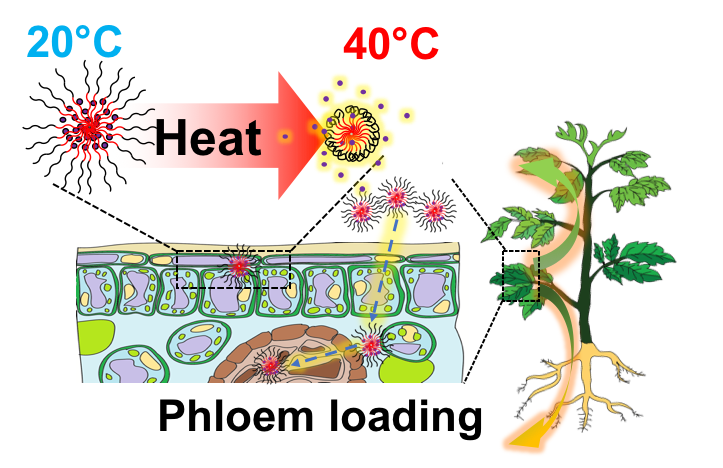
Image Credit: Carnegie Mellon University
New research suggests that nanotechnology could help protect plants against heat stress caused by soaring temperatures and lengthy heatwaves. The breakthrough is the next step in a field provisionally referred to as ‘plant therapeutics’ that could revolutionize agriculture.
Any budding gardener will tell you about the difficulty of protecting planets during hot weather conditions. Whilst some plants such as succulents like the cacti family are well equipped to deal with soaring temperatures, others can’t conserve water and in hot conditions and will start to wilt, dry up, or even die. With heatwaves becoming both more common and more sustained as a result of climate change, this problem is more than a mere inconvenience.
In excessively hot weather, many vegetable crops can exhibit severe problems in production, threatening the economy and in developing countries, the health of communities and individuals. A novel and effective way of tackling heat stress is desperately needed.
Fortunately, new research published in the journals ACS Nano and Nature Food suggests that nanotechnology could be used to tackle this growing problem, helping protect plants and crops against heat stress.
The authors, including Civil and Environmental Engineering’s Greg Lowry, describe the creation of nanoparticles (NP) and NP coatings that, in combination with the right polymers, can be applied to the leaves of plants with an uptake of 99% delivering agents that can provide ‘heat stress relief agents’ on-demand to the plants.
Lowry describes the breakthrough as the next step in the development of the newly emerging field of ‘plant therapeutics.’ Working in this area, Lowry and his team, including Chemical Engineering’s Bob Tilton, aim to ‘immunize’ planets against some of the stresses that put pressure on agriculture — namely extreme heat and drought. Their recent research represents the first practical demonstration of a temperature-programmed release of an antimicrobial agent with a plant.
“Prolonged high temperatures can induce stress in crop plants,” says Tilton in a press release. “Our materials are designed so they can bind heat stress relief agents and release them inside the plant on demand when it becomes very hot.”
Nanoparticles and Star Polymers to Provide Stress Relief
The nanoparticles that the team developed are a new form of star polymer — a simple class of branched polymer with linear chains spreading out from a central core — with each containing crystal violet (CV). This CV is a model antimicrobial agent that can be released to a plant, based on it reaching a certain temperature — between 20⁰C and 40⁰C dependant on pH levels.
To conduct their research, the scientists sprayed the NPs onto the leaves of a tomato plant, observing absorptions rates in the range of 99% — a take-up level much higher than currently favored agent delivery methods. Following this application, the NPs were able to circulate throughout the entire plant over the subsequent three days. The programmed release of the CV occurred with the plants once the temperature reached 35⁰C — 40⁰C thus triggering the NPs’ release properties.
The beauty of the system described above is that the NPs lie dormant until they are needed when temperatures soar or a heatwave strikes. At this time only, the polymers release the CVs into the plant giving it the boost needed to stave off heat stress.
Lowry and Tilton aren’t planning on leaving their newly developed modality there. They plan to delve much further into plant therapeutics by developing similar agents that could fight off dangerous pathogens during bouts of heat stress, or even prevent heat stress altogether by stimulating photosynthesis within the subject plants.
“Polymers with qualitatively similar characteristics have been investigated for use as drug delivery vehicles for medical therapies,” says Tilton.
Of course, the conditions under which drug delivery vehicles and agrochemical vehicles must work, and the types of physical and chemical signals that can be exploited for stimulus-responsive release of the active agents, are quite different. The key was to design the right chemical properties into our vehicles to suit the crop protection applications.
Bob Tilton, Chevron Professor, Chemical Engineering, Biomedical Engineering, CMU
Despite these initial positive results, if nanotechnology is to make the leap from researchers’ labs to the farmers’ fields much more testing is needed to demonstrate that it can be effectively and cost-efficiently ‘scaled-up’ from a few plants to an entire crop. And of course, further testing will require a much greater financial investment.
Results such as these obtained by Lowry and his team demonstrate that the application of nanotechnology to the world of agriculture to solve growing problems such as rising temperatures, the loss of arable land, growing populations, and water shortages is there — if we want it.
Sources and Further Reading
Zhang. Y., Yan. J., Lowery. G. V., et al, [2020], ‘Temperature- and pH-Responsive Star Polymers as Nanocarriers with Potential for in Vivo Agrochemical Delivery,’ ACS NANO.
Hofmann. T., Lowry. G. V., Ghoshal. S., et al, [2020], ‘Technology readiness and overcoming barriers to sustainably implement nanotechnology-enabled plant agriculture,’ Nature Food.
Disclaimer: The views expressed here are those of the author expressed in their private capacity and do not necessarily represent the views of AZoM.com Limited T/A AZoNetwork the owner and operator of this website. This disclaimer forms part of the Terms and conditions of use of this website.